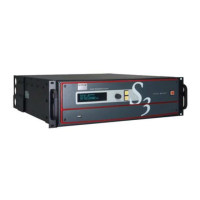R5905948 /12 Event Master Devices40
DA (Distribution Amplifier)
A video device that inputs one video signal, and outputs multiple “identical” signals.
Destination (DST)
A Destination is a location to which you can route the output of an Event Master device. A destination can be
configured as a group of one or more outputs that feed the same screen.
A Destination can be a single, widescreen or multi-screen. Mixing Layers are assigned to Destinations.
A Destination can transition Backgrounds and Mixing Layers.
Event Master Control Software (EM GUI)
This user's guide refers to the Event Master control software as the EM GUI. The software consists of several
menus and tabs that enable you to configure your system, setup the input sources and output Destinations,
manage the dedicated Multiviewer and create your presentation’s overall “look.” Refer to the chapter “EM GUI
orientation”, page 103 for more information about the EM GUI.
Event Master Series Processor (EMP)
Any Event Master series processor—E2 Gen 2, E2, E2 Jr., S3–4K, S3–4K Jr., or EX—may be referred to as
an EMP.
Event Master Toolset Software (EMTS)
Event Master Toolset Software is an easy to use GUI running on a PC or MAC. It provides all the Event Master
series processors with control and configuration.
Fader
See T-Bar.
GUI (Graphical User Interface)
A term that describes a status display based on graphics and icons, rather than strictly on numbers and
letters.
Input
The actual input connector of a processor.
Key
An electronic (and visual) process whereby one image is electronically superimposed over another source or
background. Keys are typically used for titles, logos, and banners.
Keyframe
In a PIP “move,” a keyframe is a point where an action or change occurs. For example, when a PIP moves
from the upper right corner to full screen, keyframe 1 is the upper right position, and keyframe 2 is the full
screen position of the PIP.
Key Fill
The video which fills the hole cut by the keying circuitry. Typically, switchers provide a variety of choices for the
fill source — internal mattes, external video, or "self" fill are several examples.
Key Signal
Also known as Key Source. The signal that electronically cuts the hole in the background video signal. Key
signals typically originate from external inputs such as character generators or cameras.
Layer
An image display element (such as a PIP, Key or Background) that has an associated visual priority — either
in front (or in back) of another layer.
General

